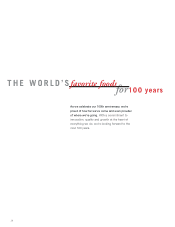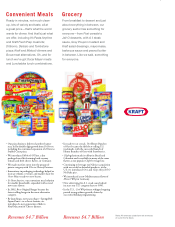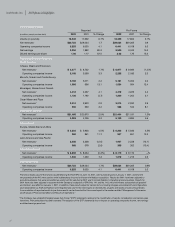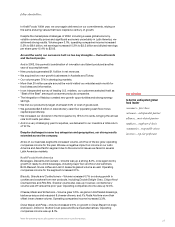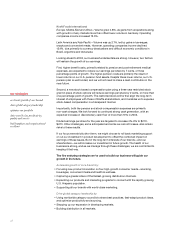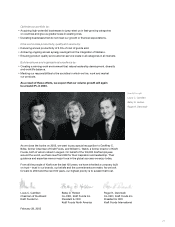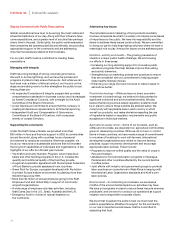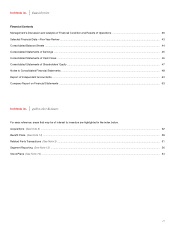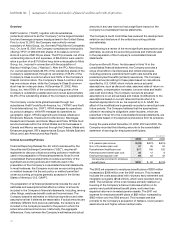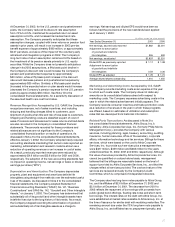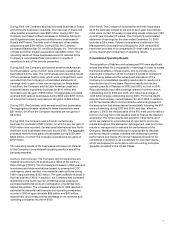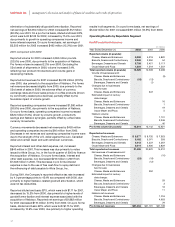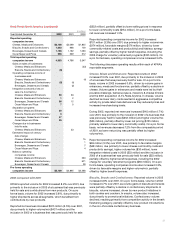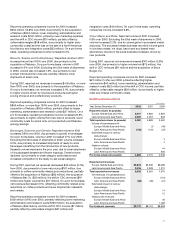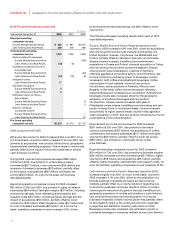Kraft 2002 Annual Report Download - page 30
Download and view the complete annual report
Please find page 30 of the 2002 Kraft annual report below. You can navigate through the pages in the report by either clicking on the pages listed below, or by using the keyword search tool below to find specific information within the annual report.
kraft foods inc. management’s discussion and analysis of financial condition and results of operations
Overview
Kraft Foods Inc. (“Kraft”), together with its subsidiaries
(collectively referred to as the “Company”) is the largest branded
food and beverage company headquartered in the United States.
Prior to June 13, 2001, the Company was a wholly-owned
subsidiary of Altria Group, Inc. (formerly Philip Morris Companies
Inc.). On June 13, 2001, the Company completed an initial public
offering (“IPO”) of 280,000,000 shares of its Class A common
stock at a price of $31.00 per share. The IPO proceeds, net of the
underwriting discount and expenses, of $8.4 billion were used to
retire a portion of an $11.0 billion long-term note payable to Altria
Group, Inc., incurred in connection with the acquisition of
Nabisco Holdings Corp. (“Nabisco”). After the IPO, Altria Group,
Inc. owned approximately 83.9% of the outstanding shares of the
Company’s capital stock through its ownership of 49.5% of the
Company’s Class A common stock and 100% of the Company’s
Class B common stock. The Company’s Class A common stock
has one vote per share, while the Company’s Class B common
stock has ten votes per share. At December 31, 2002, Altria
Group, Inc. held 97.8% of the combined voting power of the
Company’s outstanding capital stock and owned approximately
84.2% of the outstanding shares of the Company’s capital stock.
The Company conducts its global business through two
subsidiaries: Kraft Foods North America, Inc. (“KFNA”) and Kraft
Foods International, Inc. (“KFI”). KFNA manages its operations
by product category, while KFI manages its operations by
geographic region. KFNA’s segments are Cheese, Meals and
Enhancers; Biscuits, Snacks and Confectionery; Beverages,
Desserts and Cereals; and Oscar Mayer and Pizza. KFNA’s food
service business within the United States and its businesses in
Canada and Mexico are reported through the Cheese, Meals and
Enhancers segment. KFI’s segments are Europe, Middle East and
Africa; and Latin America and Asia Pacific.
Critical Accounting Policies
Financial Reporting Release No. 60, which was issued by the
Securities and Exchange Commission (“SEC”), requires all
registrants to discuss critical accounting policies or methods
used in the preparation of financial statements. Note 2 to the
consolidated financial statements includes a summary of the
significant accounting policies and methods used in the
preparation of the Company’s consolidated financial statements.
In most instances, the Company must use an accounting policy
or method because it is the only policy or method permitted
under accounting principles generally accepted in the United
States of America (“U.S. GAAP”).
The preparation of all financial statements includes the use of
estimates and assumptions that affect a number of amounts
included in the Company’s financial statements, including, among
other things, employee benefit costs and income taxes. The
Company bases its estimates on historical experience and other
assumptions that it believes are reasonable. If actual amounts are
ultimately different from previous estimates, the revisions are
included in the Company’s results for the period in which the
actual amounts become known. Historically, the aggregate
differences, if any, between the Company’s estimates and actual
amounts in any year have not had a significant impact on the
Company’s consolidated financial statements.
The Company’s Audit Committee has reviewed the development,
selection and disclosure of the critical accounting policies
and estimates.
The following is a review of the more significant assumptions and
estimates, as well as the accounting policies and methods used
in the preparation of the Company’s consolidated financial
statements:
Employee Benefit Plans: As discussed in Note 14 to the
consolidated financial statements, the Company provides a
range of benefits to its employees and retired employees,
including pensions, postretirement health care benefits and
postemployment benefits (primarily severance). The Company
records amounts relating to these plans based on calculations
specified by U.S. GAAP, which include various actuarial
assumptions, such as discount rates, assumed rates of return on
plan assets, compensation increases, turnover rates and health
care cost trend rates. The Company reviews its actuarial
assumptions on an annual basis and makes modifications to the
assumptions based on current rates and trends when it is
deemed appropriate to do so. As required by U.S. GAAP, the
effect of the modifications is generally recorded or amortized over
future periods. The Company believes that the assumptions
utilized in recording its obligations under its plans, which are
presented in Note 14 to the consolidated financial statements, are
reasonable based on its experience and advice from its actuaries.
During the years ended December 31, 2002, 2001 and 2000, the
Company recorded the following amounts in the consolidated
statement of earnings for employee benefit plans:
(in millions)
2002 2001 2000
U.S. pension plan income $ (33) $(227) $(315)
Non-U.S. pension plan cost 47 35 34
Postretirement healthcare cost 217 199 126
Postemployment benefit plan cost 35 12 9
Employee savings plan cost 64 63 43
Net expense (income) for employee
benefit plans $330 $ 82 $(103)
The 2002 net expense for employee benefit plans of $330 million
increased by $248 million over the 2001 amount. This increase
includes the costs associated with voluntary early retirement and
integration programs ($148 million), which were recorded during
2002. The remainder of the cost increase primarily relates to a
lowering of the Company’s discount rate assumption on its
pension and postretirement benefit plans, and lower than
expected returns on invested pension assets. The 2001 net
expense for employee benefit plans of $82 million increased by
$185 million over the 2000 amount. This increase was due
primarily to the Company’s acquisition of Nabisco, lower pension
asset returns and higher retiree medical costs.
26


